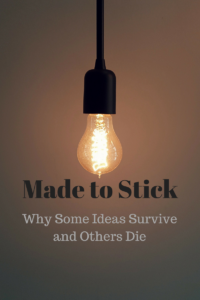(This post contains affiliate links.)
While I am not a perfect writer, I am constantly looking for resources to help me become a better writer myself so I can pass what I learn on to the graduate students I teach. During one such search, I came across the book Made to Stick: Why Some Ideas Survive and Others Die by Chip and Dan Heath. With a cover that feels like actual duct tape and one of the authors in education, I was sold.
I teach graduate students how to establish strong writing habits to increase their academic writing development. It is a role that was unexpected and has become a greater blessing than I ever imagined. Does this mean I am a perfect writer? Absolutely not! What it means is I have developed strong writing habits of my own (write daily, log my writing, accountability) and I have the ability to pass these skills on to others.
What I found while reading “Made to Stick” was not only a book to increase my writing development but a resource applicable for teachers, bloggers, marketing managers, business owners, and basically anyone who wants to deliver information others will remember. So, if you find yourself wanting to get your message across and looking for great ways to do it, you should read this book.
The message behind this book is all great ideas have some basic features. Specifically, “many of us struggle with how to communicate ideas effectively, how to get our ideas to make a difference” (p. 5). Even when we have great ideas, how do we make them matter to others?
As a classroom teacher, I would spend HOURS planning lessons and developing ideas I thought would help my students learn and retain a new concept. Sometimes my best plans, the ones I was most excited about, fell short for my students. It was disappointing but more than that, I worried they did not actually learn or retain what I planned for them too. In the time constrained world of K-12 education, there is little time for lessons to flop. I wish I had the ideas shared in this book to help frame my lessons.
The basics described in this book on how to make an idea “stick” include:
- Simplicity
- Unexpectedness
- Concreteness
- Credibility
- Emotions
- Stories
While every lesson or idea does not include all of these basics, many do. Reflecting on my lessons that flopped as a teacher, I now realize I could have incorporated many of these features and made my lessons “stick”.
As I sat in church this morning, I was listening to my pastor and this book came to mind. My pastor is an amazing speaker. It is obvious that preaching is truly his gift from God. It seems to come effortlessly to him. As we all know, for something to look effortless, a great deal of work has gone into the development of that skill. Think Michael Jordan, George Strait, and the smartest person you know.
My pastor has the ability to take God’s word and apply the basics as listed in “Made to Stick”. He first takes an often difficult concept and explains it simply so those of us who do not study the bible can understand. He finds ways to share God’s message in a concrete way, emphasizing the unexpected and amazing things God does for us. He then brings in stories to add credibility and relatability to help trigger emotions. Has he read this book, I have no idea, but he has found a way to make an audience of hundreds of people hang on his every word to learn God’s word. It is amazing and something I have never seen before. He makes his message “stick”, making God’s message “stick”.
Not only do I want to be able to share God’s word in this way but I want to be a teacher who can make my message “stick” in the same manner. The book goes on to give various examples of ideas that “stick” and what made them have this sticking power. Through simple and engaging writing, the Dean brothers deliver a message we all will benefit from hearing. Each basic (simplicity, unexpectedness, concreteness, credibility, emotions, and stories) is well described and detailed in the book and helps you develop your own ways to deliver a message.
If you have read this book, comment on your thoughts and reactions and let me know what you think.



This sounds like a great read, I’ll have to check it out. I’m always looking for different approaches to take with my toddler, he is an absolute sponge so technique really is everything. Thanks for sharing this!!
I like the quote you included about communicating ideas that make a difference. When I am making a lesson plan I try to get to the core of what students really need to know and work from there so it is simple and has credibility as you mentioned. I also think it’s important to explain why learning the concept will benefit the students so they know they have a reason to learn it and it’s not busy work. Thanks for the book recommendation!
I often find myself stuck and looking for ways to learn how to communicate effectively on “paper”. Story writing is an art. Practice and the right guidance can make a world of difference. Thank you for the recommendation on the book!
i love the idea about your writing that is not perfect yet you were able to make impact.
Thank you!
I thought writing would be easy since I have taught ELA. Not so much. I have oodles of ideas, getting those on paper in an intriguing way is sometimes a struggle.